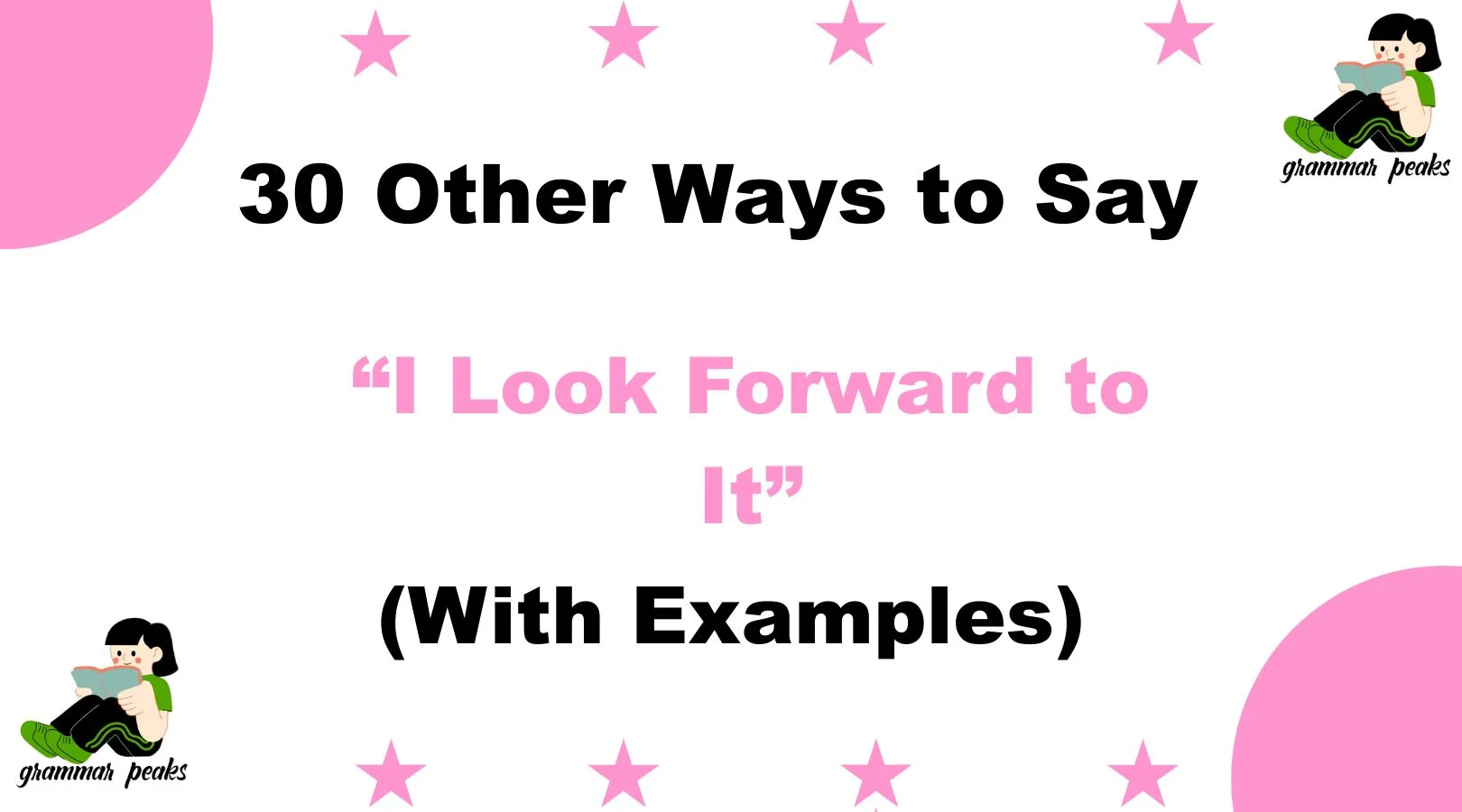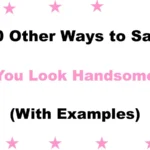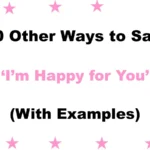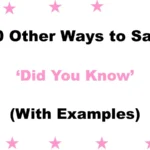Expressing excitement of anticipation in words that feel warm, thoughtful, and genuine can truly brighten someone’s day. Instead of sticking with the usual phrase, “I look forward to it,” why not explore some creative alternatives that bring more personality and care to your message? Whether in emails, texts, or conversations, these expressions can help you connect more deeply and show sincere interest.
This article shares 30 heartfelt ways to say “I look forward to it,” with clear explanations and examples to guide you. Understanding when and how to use these phrases will ensure your words come across as polite, professional, or friendly, depending on the occasion. Let’s dive in and discover how to make your communication feel even more meaningful!
What Does “I Look Forward to It” Mean?
The phrase “I look forward to it” means that someone is eagerly anticipating or excited about something that will happen in the future. When a person says this, they are expressing positive feelings and enthusiasm about an upcoming event, meeting, or experience. It shows that they expect it with pleasure and are waiting for it with interest.
For example, if someone says, “I look forward to our meeting,” they mean they are happy and ready to meet soon. Overall, it’s a polite and friendly way to show optimism and anticipation.
When to Use “I Look Forward to It”
Use “I look forward to it” when you want to:
- Politely express excitement about upcoming plans or events
- End emails or conversations on a positive, hopeful note
- Show interest in future interactions, such as meetings, calls, or social gatherings
It works well in both professional and personal contexts but can sometimes feel a bit generic or formal.
Is It Professional/Polite to Say “I Look Forward to It”?
Yes, “I look forward to it” is both professional and polite. It’s a safe, respectful way to express anticipation. However, if you want to sound more personal or engaging, choosing alternatives that match your tone can be more effective.
Pros and Cons of Using “I Look Forward to It”
Pros:
- Clear and universally understood
- Polite and appropriate in almost all situations
- Simple and concise
Cons:
- Can feel repetitive or bland
- May come across as overly formal or impersonal
- Lacks emotional warmth in casual contexts
Synonyms for “I Look Forward to It”
- Can’t wait for it
- Excited about it
- Eagerly awaiting it
- Anticipating it with joy
- Counting down the days
- Looking ahead to it
- Thrilled for it
- Awaiting it eagerly
- Looking forward with enthusiasm
- Can hardly wait
- Anxiously awaiting
- Enthusiastic about it
- Waiting with anticipation
- Delighted about it
- Ready and waiting
- Very much looking forward to it
- Can’t wait to see it happen
- Hopeful for it
- Awaiting with excitement
- Looking ahead with pleasure
- Thrilled to experience it
- Keen on it
- Counting the moments
- Can’t wait to get started
- Over the moon about it
- Looking forward with joy
- Waiting eagerly for it
- Excitedly anticipating
- Hopeful and ready
- Waiting in great expectation
1. I’m Excited About It
Definition: Expresses genuine enthusiasm and positive energy toward something coming up.
Explanation: This phrase adds a lively tone, showing you’re truly eager.
Example: “I’m excited about our meeting next week!”
Best Use: Friendly conversations, informal emails.
Worst Use: Very formal business settings where restrained language is preferred.
Tone: Warm, enthusiastic, approachable.
2. Can’t Wait!
Definition: A casual way to express impatience and eagerness.
Explanation: Shows a high level of excitement, often used in informal communication.
Example: “Can’t wait to see you at the party!”
Best Use: Texts, chats with friends, informal emails.
Worst Use: Formal or professional correspondence.
Tone: Playful, informal, upbeat.
3. I’m Looking Forward to It With Great Anticipation
Definition: A more formal and detailed way of expressing eager expectation.
Explanation: Adds depth to the standard phrase, making it sound more thoughtful.
Example: “I’m looking forward to the conference with great anticipation.”
Best Use: Formal emails, official invitations.
Worst Use: Casual conversations.
Tone: Polite, respectful, earnest.
4. I’m Eager to See It Happen
Definition: Shows strong desire and readiness for an event or outcome.
Explanation: Implies active interest and enthusiasm.
Example: “I’m eager to see the results of your project.”
Best Use: Professional and personal contexts.
Worst Use: Situations requiring neutral or minimal emotional expression.
Tone: Positive, proactive, sincere.
5. I’m Counting the Days
Definition: Expresses excitement by emphasizing the wait time.
Explanation: Adds a playful or heartfelt touch by focusing on the anticipation.
Example: “I’m counting the days until our vacation!”
Best Use: Friendly and informal settings.
Worst Use: Formal emails or when professionalism is essential.
Tone: Warm, informal, personal.
6. I Am Anticipating It With Pleasure
Definition: A polished and courteous way to express eagerness.
Explanation: Combines anticipation with a sense of enjoyment.
Example: “I am anticipating the seminar with pleasure.”
Best Use: Business or formal communication.
Worst Use: Very casual chats.
Tone: Formal, respectful, pleasant.
7. Looking Ahead to It
Definition: A simple phrase indicating future-focused enthusiasm.
Explanation: Less formal, but still polite and positive.
Example: “Looking ahead to our collaboration.”
Best Use: Semi-formal emails, professional but friendly notes.
Worst Use: Very formal or very casual.
Tone: Neutral, optimistic, polite.
8. Can’t Wait to Get Started
Definition: Expresses eagerness to begin a task or event.
Explanation: Shows enthusiasm focused on the action rather than just the event.
Example: “Can’t wait to get started on the new project!”
Best Use: Team communications, informal professional contexts.
Worst Use: Formal correspondence or when expressing anticipation of non-work events.
Tone: Energetic, informal, motivated.
9. I’m Thrilled About It
Definition: A strong emotional expression of excitement.
Explanation: Adds a sense of joy and enthusiasm.
Example: “I’m thrilled about your upcoming presentation!”
Best Use: Personal and semi-formal contexts.
Worst Use: Overly formal situations or with reserved audiences.
Tone: Joyful, enthusiastic, expressive.
10. Excited to See What Happens
Definition: Shows curiosity and eagerness regarding an uncertain outcome.
Explanation: Indicates openness and positive expectation.
Example: “Excited to see what happens with the new initiative.”
Best Use: Informal business or friendly conversations.
Worst Use: Formal or overly structured settings.
Tone: Curious, hopeful, casual.
11. I’m Ready and Looking Forward
Definition: Combines preparedness with anticipation.
Explanation: Suggests both eagerness and confidence.
Example: “I’m ready and looking forward to the meeting.”
Best Use: Professional and semi-formal.
Worst Use: Overly casual or personal conversations.
Tone: Confident, positive, polite.
12. Awaiting With Excitement
Definition: A formal way to express eager waiting.
Explanation: Emphasizes patient excitement.
Example: “I am awaiting the launch with excitement.”
Best Use: Business announcements and formal emails.
Worst Use: Casual texting or informal chats.
Tone: Formal, respectful, enthusiastic.
13. I’m Delighted to Anticipate It
Definition: Expresses pleasure in expectation.
Explanation: Polite and warm, suitable for formal and informal use.
Example: “I’m delighted to anticipate our collaboration.”
Best Use: Emails and letters requiring warmth.
Worst Use: Too formal for some casual settings.
Tone: Warm, courteous, positive.
14. Enthusiastic About It
Definition: A straightforward phrase showing eagerness.
Explanation: Communicates energy and interest clearly.
Example: “I’m enthusiastic about the upcoming event.”
Best Use: Professional and casual conversations.
Worst Use: Situations needing softer tones.
Tone: Positive, direct, friendly.
15. I’m Hoping for It
Definition: Shows desire and positive expectation.
Explanation: Slightly less certain, more hopeful in tone.
Example: “I’m hoping for a successful outcome.”
Best Use: When results are uncertain.
Worst Use: When certainty or confidence is needed.
Tone: Hopeful, tentative, sincere.
16. Eagerly Awaiting
Definition: Emphasizes the excitement in the waiting process.
Explanation: Conveys strong anticipation.
Example: “Eagerly awaiting the team’s feedback.”
Best Use: Professional and personal settings.
Worst Use: Overly formal contexts.
Tone: Warm, positive, active.
17. I’m Looking Forward With Joy
Definition: Adds emotional warmth to anticipation.
Explanation: Highlights happiness about what’s coming.
Example: “Looking forward with joy to our reunion.”
Best Use: Personal messages, friendly emails.
Worst Use: Formal business communication.
Tone: Joyful, affectionate, heartfelt.
18. Anticipating With Great Excitement
Definition: Strong formal expression of excitement.
Explanation: A polished phrase for special occasions.
Example: “Anticipating with great excitement the product launch.”
Best Use: Formal business events.
Worst Use: Casual conversations.
Tone: Enthusiastic, formal, polished.
19. Can’t Wait to Catch Up
Definition: Informal phrase focused on reconnecting.
Explanation: Friendly and casual.
Example: “Can’t wait to catch up soon!”
Best Use: Friends, family, casual colleagues.
Worst Use: Formal or first-time contacts.
Tone: Warm, friendly, casual.
20. Looking Forward to Sharing It With You
Definition: Indicates excitement to share an experience.
Explanation: Emphasizes connection and inclusion.
Example: “Looking forward to sharing this moment with you.”
Best Use: Personal and semi-formal.
Worst Use: Overly formal contexts.
Tone: Inclusive, warm, thoughtful.
21. I’m Counting On It
Definition: Shows expectation with confidence.
Explanation: Indicates trust in the event happening.
Example: “I’m counting on our meeting going well.”
Best Use: Confident, informal-professional contexts.
Worst Use: Situations needing softer tones.
Tone: Confident, assertive, hopeful.
22. Excited to Connect
Definition: Focuses on building relationships.
Explanation: Shows enthusiasm for interaction.
Example: “Excited to connect next week.”
Best Use: Networking, semi-formal emails.
Worst Use: Overly formal letters.
Tone: Friendly, approachable, positive.
23. Can’t Wait to Hear From You
Definition: Expresses eagerness for communication.
Explanation: Often used to prompt replies.
Example: “Can’t wait to hear from you soon!”
Best Use: Informal and semi-formal correspondence.
Worst Use: Formal, one-way communications.
Tone: Friendly, encouraging, casual.
24. Looking Forward to Our Time Together
Definition: Emphasizes shared experience.
Explanation: Warm and personal phrase.
Example: “Looking forward to our time together this weekend.”
Best Use: Personal and semi-formal contexts.
Worst Use: Very formal or professional-only contexts.
Tone: Warm, caring, inclusive.
25. I’m Anxiously Anticipating It
Definition: Conveys excitement mixed with slight nervousness.
Explanation: Expresses eagerness with emotional depth.
Example: “I’m anxiously anticipating the interview results.”
Best Use: Personal, emotionally charged situations.
Worst Use: Formal or neutral contexts.
Tone: Emotional, sincere, vulnerable.
26. Ready and Excited
Definition: Shows preparedness combined with enthusiasm.
Explanation: Positive and proactive.
Example: “Ready and excited for the challenge ahead!”
Best Use: Motivational, professional teams.
Worst Use: Casual or formal reserved conversations.
Tone: Energetic, confident, upbeat.
27. Looking Forward to What’s Next
Definition: General phrase indicating positive anticipation.
Explanation: Open-ended and optimistic.
Example: “Looking forward to what’s next in the project.”
Best Use: Business and casual conversations.
Worst Use: When specific anticipation is required.
Tone: Optimistic, flexible, positive.
28. I’m Pumped About It
Definition: Slang phrase showing high energy.
Explanation: Very informal and enthusiastic.
Example: “I’m pumped about the game tonight!”
Best Use: Friends, informal teams.
Worst Use: Formal or professional settings.
Tone: Energetic, informal, youthful.
29. Excited to Embark On This Journey
Definition: Expresses eagerness about a new experience or phase.
Explanation: Warm and poetic.
Example: “Excited to embark on this journey with you.”
Best Use: Personal, inspirational contexts.
Worst Use: Straightforward, formal business communication.
Tone: Inspirational, heartfelt, warm.
30. Looking Forward to the Opportunity
Definition: Polite and professional expression of anticipation.
Explanation: Shows appreciation and eagerness about a chance or offer.
Example: “Looking forward to the opportunity to collaborate.”
Best Use: Job interviews, formal meetings.
Worst Use: Informal, casual conversations.
Tone: Respectful, professional, positive.
Conclusion
Finding different ways to say “I look forward to it” allows you to communicate warmth, care, and thoughtful anticipation in ways that suit your personality and context. Whether you want to sound friendly, formal, enthusiastic, or professional, there’s a phrase that fits. Using these alternatives thoughtfully not only enhances your message but also helps build deeper connections and leaves a memorable impression. Always consider your audience, tone, and the situation to pick the best expression—this makes your communication more meaningful and effective. Embrace variety, and watch your words spark genuine anticipation and positive feelings!
Frequently Asked Questions
1. What does “I look forward to it” really mean?
Definition: It expresses anticipation or excitement about a future event or meeting. It shows that you care about what’s coming next.
Explanation: Saying “I look forward to it” communicates positivity and eagerness, making the listener feel valued and appreciated.
2. When is the best time to use alternatives to “I look forward to it”?
Answer: Use alternatives when you want to sound more personal, warm, or professional depending on the situation. It’s ideal when writing emails, messages, or having conversations where you want to add a fresh, genuine touch.
3. Are all these alternatives appropriate for professional settings?
Answer: Many alternatives are perfect for professional communication, such as “I’m eager to collaborate” or “I anticipate our meeting.” However, some phrases might be too casual for formal emails, so choose based on the relationship and context.
4. Can using different ways to say “I look forward to it” improve my communication?
Answer: Absolutely! Varying your expressions shows thoughtfulness, helps keep conversations engaging, and can strengthen personal or professional connections.
5. What tone should I use when replacing “I look forward to it”?
Answer: The tone should match your intent—whether warm, enthusiastic, formal, or casual. For example, “Excited to see you soon!” is casual and friendly, while “Anticipating our discussion” is more formal and respectful.

Mia Rose is a passionate Language Coach and Contributor at GrammarPeaks, where she specializes in practical grammar tips and language learning strategies. With a strong foundation in education and communication, Mia brings a friendly, approachable style to her writing. Her goal is to make complex grammar rules simple and usable for learners at any level, helping them grow in both confidence and fluency.





